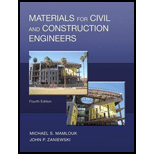
Two batches of concrete cylinders were made with and without a calcium chloride (CaCl2) accelerator admixture. Five cylinders were made of each batch and submerged in water for different times before testing for compressive strength and the results are shown in Table P6.36.

It is required to do the following:
a. Using an Excel sheet, plot the relationship between curing time and compressive strength of the two mixes on the same graph. Label all axes and curves.
b. Comment on the effect of the accelerator on the compressive strength of PCC at early and late ages.
Want to see the full answer?
Check out a sample textbook solution
Chapter 6 Solutions
Materials for Civil and Construction Engineers (4th Edition)
Additional Engineering Textbook Solutions
Foundation Design: Principles and Practices (3rd Edition)
Starting Out With Visual Basic (8th Edition)
Computer Science: An Overview (13th Edition) (What's New in Computer Science)
C How to Program (8th Edition)
Mechanics of Materials (10th Edition)
Starting out with Visual C# (4th Edition)
- Two batches of concrete cylinders were made with and without a calciumchloride (CaCl2) accelerator admixture. Six cylinders were made of each batch andsubmerged in water for different times before testing for compressive strengthand the results are shown in Table P6.35.It is required to do the following:a. Using an Excel sheet, plot the relationship between curing time andcompressive strength of the two mixes on the same graph. Label all axesand curves.b. Comment on the effect of the accelerator on the compressive strength ofPCC at early and late ages.arrow_forwardQ1 What moisture condition should the coarse and fine aggregate be in when mixing the concrete? A Unknown B Saturated C Oven Dry D Air Dried E SSD Q2 What restriction is placed on the size of a sample of a concrete batch? A 30 L B 15 L C 20 L D 10 L E 5 Larrow_forwardCalculate the yield of concrete if the mass of the batch is 4800 kg and its density is found to be 350 kg/m3. Discuss the procedure for determining the temperature of freshly mixed concrete. How does one determine the diameter of a concrete cylinder specimen to be used in calculating its cross-sectional area?arrow_forward
- a. When is it necessary to consolidate concrete by vibration in test method C231? Discuss the process of vibration when placing and consolidating the sample.b. When rodding a layer of concrete in method C138, is it okay to hit the bottom of the measure? If not, how is it supposed to be done?c. Calculate the yield of concrete if the mass of the batch is 4800 kg and its density is found to be 350 kg/m3.arrow_forwardA materials engineer is working in a research project to evaluate the effect of one type of admixture on the compressive strength of concrete. He tested eight mortar cubes made with admixture and eight others without admixture after 28 days of curing. The compressive strengths of cubes in psi with and without admixture are shown in Table P6.40.Using the statistical t-test, is there a significant difference between the meansof the compressive strengths of the two cement mortars at a level of signifi-cance of 0.10?arrow_forwardFor fine aggregate: bulk specific gravity=2.60, SSD Bulk Specific Gravity=2.63, apparent Specific gravity= 2.68, percent absorption=1.54% For coarse aggregate= bulk specific gravity= 2.62, SSD specific gravity=2.63, apparent specific gravity= 2.65, percent absorption=1.70% From the data above, what can you conclude about these bulk aggregate, ssd bulk specific gravity, apparent specific gravity, and percent absorption? What is the effect of these value in concrete?arrow_forward
- A materials engineer is working in a research project to evaluate the effect of one type of admixture on the compressive strength of concrete. He tested eight mortar cubes made with admixture and eight others without admixture after 28 days of curing. The compressive strengths of cubes in MPa with and without admixture are shown in Table P6.38. Using the statistical t-test, is there a significant difference between the means of the compressive strengths of the two cement mortars at a level of signifi- cance of 0.10?arrow_forwardTwo batches of concrete cylinders were made with and without a calciumchloride (CaCl2) accelerator admixture. Five cylinders were made of eachbatch and submerged in water for different times before testing for compres-sive strength and the results are shown in Table P6.36.It is required to do the following:a. Using an Excel sheet, plot the relationship between curing time andcompressive strength of the two mixes on the same graph. Label all axesand curves.b. Comment on the effect of the accelerator on the compressive strength ofPCC at early and late ages.arrow_forwardQ4: A: What is self-consolidating concrete? How are its properties achieved? How are these properties measured? B: What are the three mineralogical or geological classifications of rocks, and how are they formed?arrow_forward
- What is maximum capacity of measure should be used in determining the density of the concrete if the nominal maximum aggregate size of coarse aggregate is 25.0 mm? a.) 11 Liters b.) 14 Liters c.) 6 Liters d.) 28 Litersarrow_forwardThree 100*200 mm cylindrical concrete specimens were tested for 28 days compressive strength and show 25.5 MPa, 28.6 MPa and 24.8 MPa compressive strength. a) What is the average compressive strength of this concrete? b) What is the approximate tensile strength of this concrete? c) What is the approximate modulus of elasticity of this concrete?arrow_forwardFrom the following figure, solve for the quantity of cement, sand and gravel by Volume method using (a) class "A" concrete; (b) Class B concrete.arrow_forward

 Structural Analysis (10th Edition)Civil EngineeringISBN:9780134610672Author:Russell C. HibbelerPublisher:PEARSON
Structural Analysis (10th Edition)Civil EngineeringISBN:9780134610672Author:Russell C. HibbelerPublisher:PEARSON Principles of Foundation Engineering (MindTap Cou...Civil EngineeringISBN:9781337705028Author:Braja M. Das, Nagaratnam SivakuganPublisher:Cengage Learning
Principles of Foundation Engineering (MindTap Cou...Civil EngineeringISBN:9781337705028Author:Braja M. Das, Nagaratnam SivakuganPublisher:Cengage Learning Fundamentals of Structural AnalysisCivil EngineeringISBN:9780073398006Author:Kenneth M. Leet Emeritus, Chia-Ming Uang, Joel LanningPublisher:McGraw-Hill Education
Fundamentals of Structural AnalysisCivil EngineeringISBN:9780073398006Author:Kenneth M. Leet Emeritus, Chia-Ming Uang, Joel LanningPublisher:McGraw-Hill Education
 Traffic and Highway EngineeringCivil EngineeringISBN:9781305156241Author:Garber, Nicholas J.Publisher:Cengage Learning
Traffic and Highway EngineeringCivil EngineeringISBN:9781305156241Author:Garber, Nicholas J.Publisher:Cengage Learning





